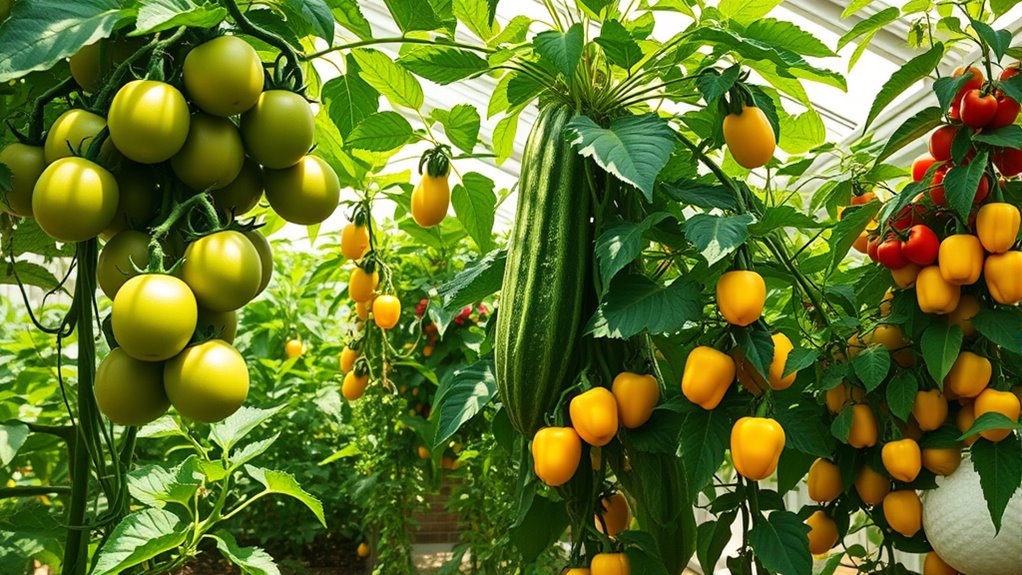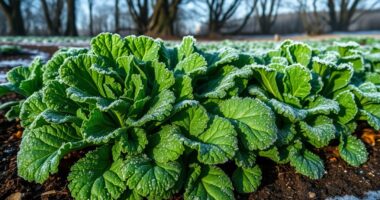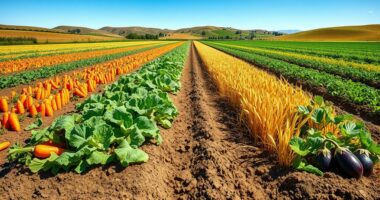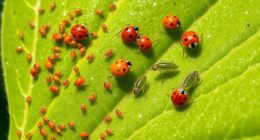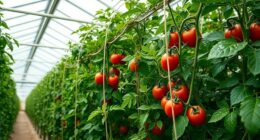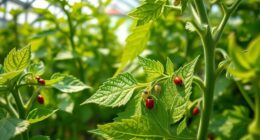If you want to maximize your summer yields, consider growing tomatoes, peppers, eggplant, cucumbers, and squash in your greenhouse. These crops thrive in the warm environment, and you can start seeds early for a bountiful harvest. Ensure they have proper sunlight, humidity, and well-drained soil for optimal growth. Don't forget to monitor for pests and maintain good air circulation. Keep exploring these options, and you'll discover even more summer vegetables that can flourish in your greenhouse.
Key Takeaways
- Tomatoes thrive in greenhouses; start seeds under warm conditions for optimal growth and fruit production.
- Peppers, both sweet and hot, require warm temperatures and good sunlight for healthy development.
- Eggplants prefer warm soil and consistent moisture, making them ideal for greenhouse cultivation.
- Cucumbers benefit from trellising and parthenocarpic varieties, ensuring a bountiful harvest without pollination.
- Squash varieties flourish in high heat and humidity, perfect for greenhouse environments, with some compact options for limited space.
Tomatoes: The Ultimate Summer Crop
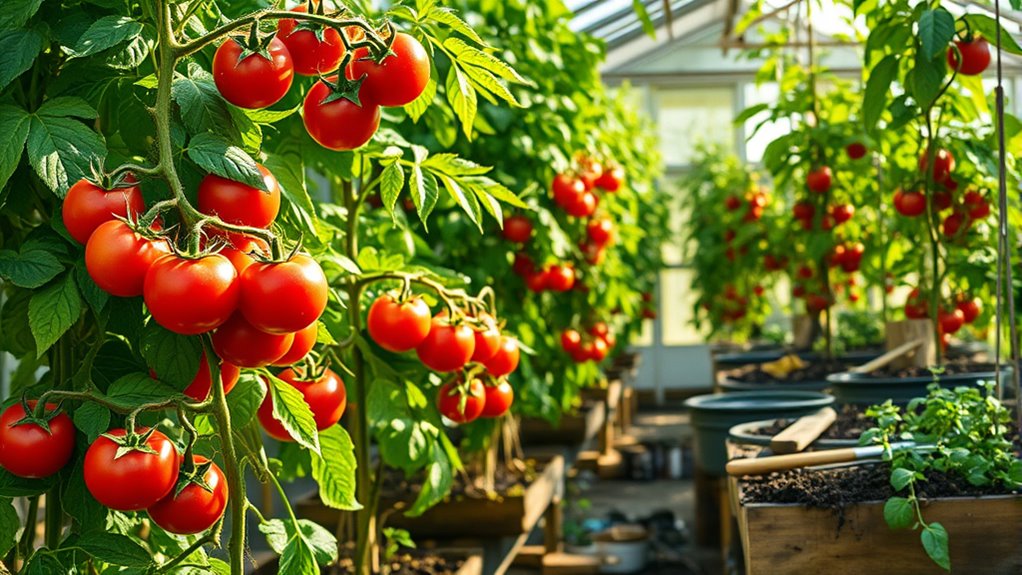
When you think of summer gardening, tomatoes are often the first crop that comes to mind.
To start your tomatoes in a greenhouse, use seeds designed for greenhouse conditions to prevent issues like Blossom End-Rot. Germinate your seeds in warm conditions under grow lights and on heat mats for best results. Sanitize containers with a mild bleach solution to prevent disease before transplanting.
Transplant your seedlings into large containers, at least 10 gallons, to give them room to grow. Ensure your greenhouse is free from diseases and pests, and consider planting herbs like basil to deter unwanted visitors.
Maintain temperatures between 60°F and 90°F and provide adequate ventilation. Regularly water and fertilize your plants, and don't forget to prune for optimal fruit production.
With the right care, you'll enjoy a bountiful harvest!
Thriving Peppers: Sweet and Hot Varieties

If you're looking to diversify your summer garden, growing peppers—both sweet and hot—can add vibrant flavors and colors to your dishes.
Sweet varieties like bell peppers, sweet banana peppers, and mini sweet peppers thrive in greenhouses, while hot options such as Little Beak, Chinese Five Colour, and Trinidad Perfume spice things up.
Sweet bell peppers and spicy varieties like Little Beak and Trinidad Perfume can elevate your summer garden.
Choose disease-resistant seeds for better performance, and consider compact varieties like 'Mohawk' for container gardening. Choosing the Right Sweet Pepper Varieties will help you decide which types best suit your garden's needs.
To ensure healthy growth, maintain daytime temperatures between 70–85°F, provide 6–8 hours of sunlight, and use nutrient-rich, well-draining soil.
Regularly fertilize and prune your plants for optimal yield.
Don't forget to monitor for pests and maintain good air circulation to keep your pepper plants thriving all summer long!
Eggplant: A Warm-Weather Favorite
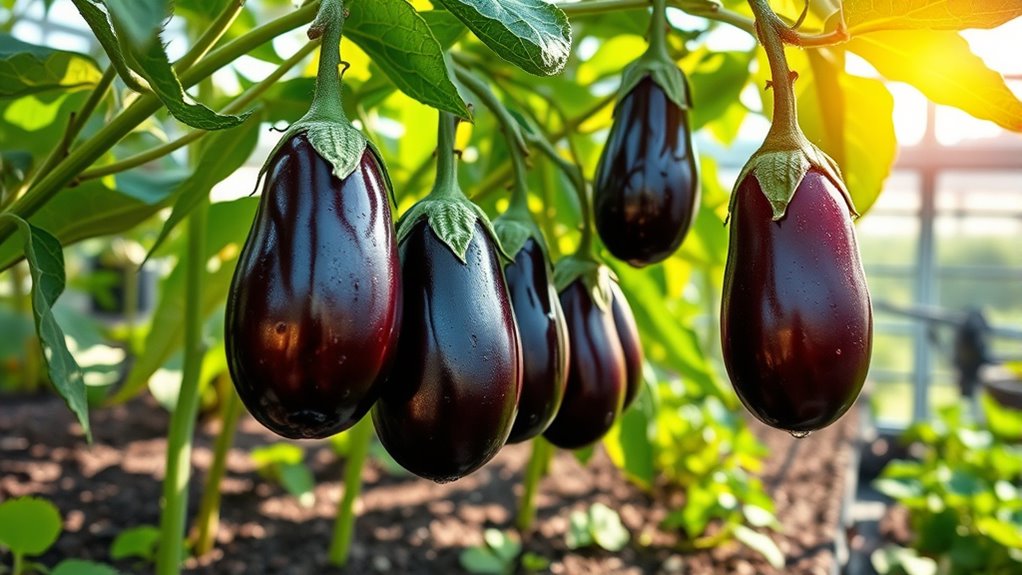
Eggplant thrives in warm weather, making it a perfect addition to your summer garden. Start by sowing seeds 6-8 weeks before transplanting, ensuring the soil temperature stays between 80°F and 90°F. Under optimal conditions, you'll see sprouts in just 8-10 days. Once your seedlings reach 10-12 inches tall, transplant them into well-drained, fertile soil, spacing plants 1 foot apart in rows 2 feet wide. Maintain daytime temperatures between 66°F and 72°F, and keep the soil consistently moist, while also providing a complete nutrient solution with an EC 2.5-3.5 for healthy growth.
Regularly inspect for pests and diseases, and consider using beneficial insects for natural control. Harvest eggplants when their skin is glossy, and remember to leave a small portion of the stem attached for the best results. Enjoy your bountiful harvest!
Quick-Growing Cucumbers
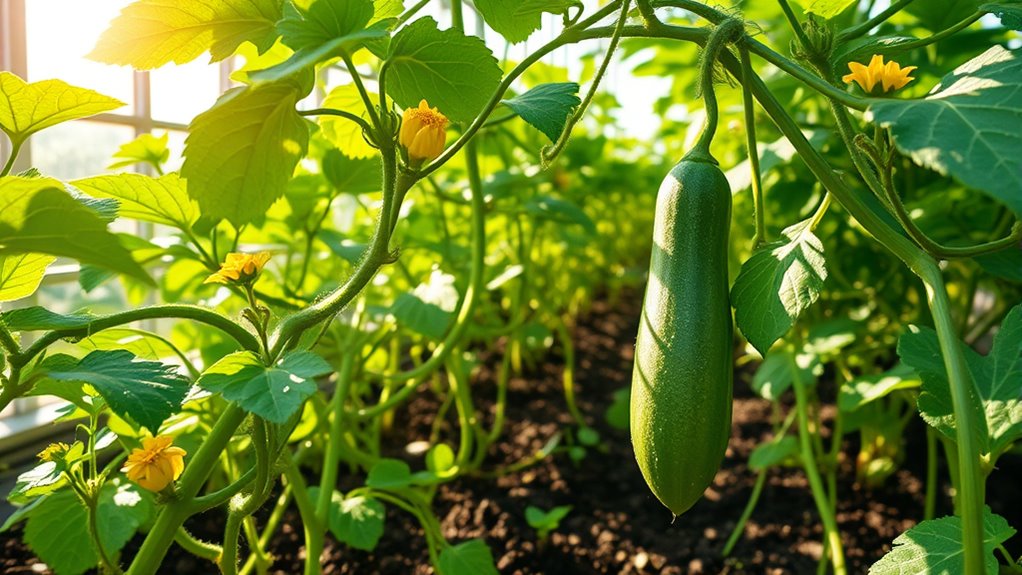
Cucumbers are a fantastic choice for summer gardens, as they grow quickly and yield abundant fruit. Opt for parthenocarpic varieties, which produce fruit without pollination—perfect for your greenhouse. Gynoecious types mostly bear female flowers, needing pollinator varieties to set fruit.
English cucumbers are long and seedless, while Beit Alpha cucumbers share similar traits. For optimal growth, maintain daytime temperatures between 75° and 80°F, ensuring humidity and ample light. Trellis your plants to maximize space and encourage larger fruits. Regular pruning improves air circulation and promotes healthy growth. Additionally, choosing disease-resistant varieties can significantly enhance your harvest success. Understanding financial considerations for growing crops can also aid in managing resources effectively.
Monitor for pests like aphids and whiteflies, and choose disease-resistant varieties for best results. Harvest cucumbers at their peak size for the best flavor and continued production.
Versatile Squash Options for Your Greenhouse
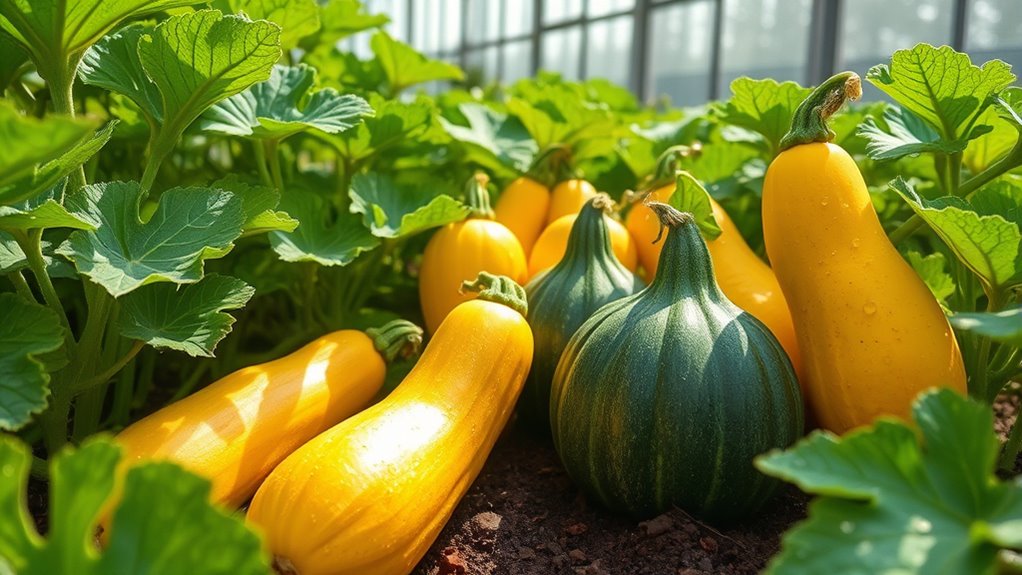
After enjoying the crisp taste of cucumbers, it's time to explore the world of squash—an equally rewarding addition to your summer greenhouse.
Consider growing summer squash varieties like 'Tempest', 'Green Machine', and 'Bossa Nova', which offer diverse colors and flavors. These plants thrive in full sun and well-drained, fertile soil. Notably, yellow crookneck varieties take longer to start fruiting but provide a long harvest period, making them a great addition to your greenhouse.
If you're short on space, try scallop or patty pan squash, which are compact and easy to manage. Notably, varieties like 'Yellowfin' and 'Bossa Nova' resist common diseases, making them reliable choices.
Hand pollination might be necessary for seed saving, but don't worry—squash grows well in high heat and humidity, perfect for your greenhouse.
With proper care, you'll enjoy a bountiful harvest!
Heat-Loving Beans and Okra
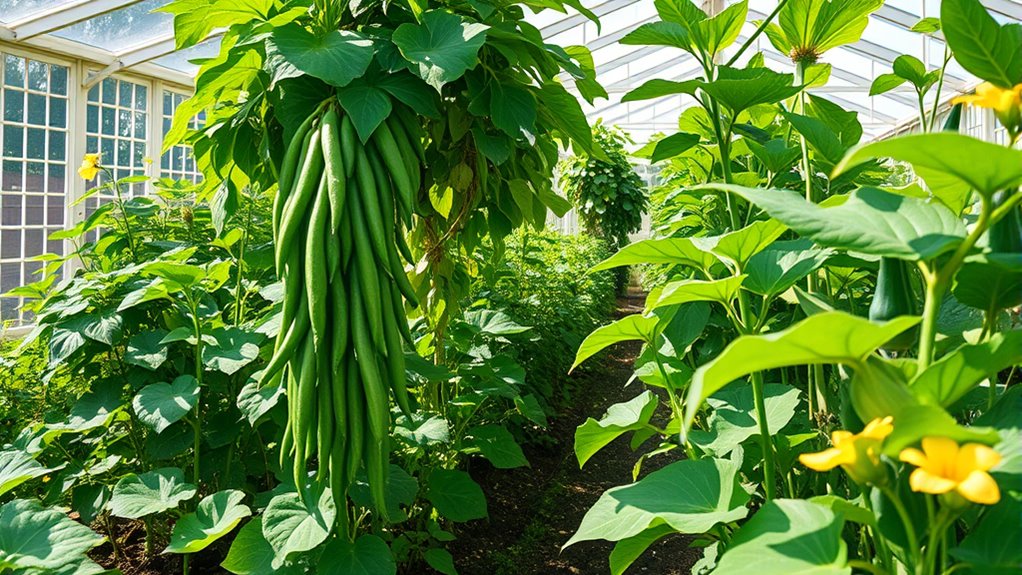
Summer heat brings a perfect opportunity to cultivate heat-loving beans and okra in your greenhouse. You can start with Tepary beans, which thrive in hot, dry conditions, or edamame, the tasty green soybeans that mature before frost. Tepary beans are known for their exceptional drought and heat tolerance, making them an ideal choice for your summer garden.
Consider yard long beans and bush varieties of Lima beans for their quick growth in high temperatures. For best results, prepare your soil with compost and mycorrhizae, soak seeds overnight, and plant them 4-6 inches apart.
Ensure good ventilation to prevent mildew and use shade cloth if temperatures rise too high. Okra, another heat-loving favorite, needs well-draining soil and consistent moisture. With proper care, both beans and okra can be delicious additions to your summer meals.
Leafy Greens and Herbs for Summer Harvests

As you explore the vibrant world of summer gardening, don't overlook the benefits of growing leafy greens and herbs. They thrive in your greenhouse with proper care, preferring temperatures between 12-18°C (55-65°F) and humidity levels of 60-80%. Maintaining optimal conditions leads to larger, higher-quality yields and can greatly enhance your summer harvest. Additionally, keeping an eye on water sources is crucial for ensuring your plants receive adequate hydration.
Consider lettuce, kale, and Swiss chard for quick summer harvests, as they mature in just 30 to 45 days. Herbs like basil and thyme can flourish alongside them, enhancing your garden's diversity.
To prevent heat stress, use shade cloth and maintain consistent moisture in well-draining soil. Hydroponics or vertical farming can maximize your space and productivity.
With careful planning, your summer greenhouse can be a delicious oasis of fresh greens and herbs!
Frequently Asked Questions
What Is the Best Time to Start Planting in the Greenhouse?
The best time to start planting in your greenhouse is in late winter or early spring, about four to six weeks before the last frost date.
This timing allows you to plant early spring vegetables, like lettuce and peas, in March and April.
For warm-season crops, aim to start around mid-March when soil temperatures are suitable for germination.
Planning for succession planting ensures a steady harvest throughout the growing season.
How Can I Control Pests in My Greenhouse?
To control pests in your greenhouse, start by using insect screens to block unwanted visitors.
Sticky traps can help catch flying pests, while high-pressure water sprays remove them from plants.
Introduce beneficial insects like ladybugs for natural pest control.
Additionally, maintain soil health and practice regular monitoring to catch issues early.
If needed, apply insecticidal soap or dormant oil carefully.
What Soil Mix Is Best for Greenhouse Vegetables?
When choosing the best soil mix for your greenhouse vegetables, you'll want a balanced blend.
Combine loam soil with compost for fertility, and add components like peat moss and perlite for aeration. A triple mix of topsoil, peat, and compost can also work wonders.
Regularly test your soil's pH, aiming for a slightly acidic to neutral range, and adjust as needed to ensure your plants thrive throughout their growth cycle.
How Much Sunlight Do Greenhouse Vegetables Need Daily?
You might be surprised to learn that greenhouse vegetables have specific sunlight needs.
Most full sun plants, like tomatoes and cucumbers, require 6-8 hours of direct sunlight daily.
Meanwhile, leafy greens and herbs thrive in partial sun, needing about 4-6 hours.
Your greenhouse's orientation and the season can also impact sunlight availability.
Can I Grow Vegetables Year-Round in My Greenhouse?
Yes, you can grow vegetables year-round in your greenhouse!
With the right materials, heating systems, and ventilation, you'll create a suitable environment for various crops.
Choose plants that match seasonal conditions and consider using automation to manage temperature and humidity effectively.
By rotating your crops and utilizing grow lights, you can maximize your yield and ensure a thriving greenhouse no matter the time of year.
Enjoy gardening all year long!
Conclusion
In your greenhouse, summer vegetables can thrive and bring joy to your garden. Whether you're savoring juicy tomatoes or crisp cucumbers, each crop adds flavor and vitality to your meals. Don't forget the herbs and greens—they'll elevate your dishes in ways you never imagined! So, why not transform your space into a vibrant summer haven? Embrace the season's bounty and enjoy the satisfaction of growing your own fresh produce. Your taste buds will thank you!
